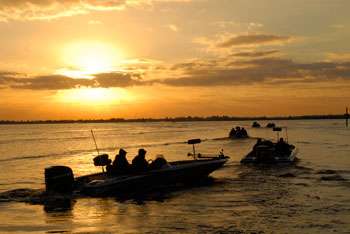
If you think sonar began with the early days of bass boats, you've got another think coming.
The word "sonar" is actually an acronym that stands for SOund, NAvigation and Ranging. It uses sound to measure things in the water — distances actually, from the unit to other vessels, to the bottom, even to fish. Over the years, anglers have commonly referred to their sonar units as "depthfinders" and "fishfinders," but they're far more than either of those names could imply.
The first recorded use of sonar occurred in 1490 when Leonardo da Vinci inserted a tube in the water and claimed he could detect ships by placing an ear to the tube. Leonardo didn't win any BASS tournaments that year, but he was clearly onto something big.
Just a little over 400 years later, likely in response to the sinking of Titanic in 1912, the British Patent Office issued the first patent for an underwater echo ranging device to Lewis Richardson. Sonar, more or less as we know it today, was off and running.
But it wasn't until much later, in the late 1950s, that sonar and recreational fishing got together to stay. That's when Carl Lowrance of Joplin, Mo., got into the mix. With his sons, Darrell and Arlen, Lowrance designed the world's first high-frequency transistorized sonar unit. They knew that if it were to be utilized by recreational anglers and boaters, it would have to be small, lightweight and relatively inexpensive. After all, anglers will pay for their toys, but they have to be affordable.
In 1957, commercial sonar units sold for more than $2,000. The first Lowrance unit cost less $150. That was still a lot of money in 1957 (a little over $1,000 in today's economy) but within reach for much of the market.
Two years later, Lowrance's "Little Green Box" revolutionized recreational sportfishing. It was a portable sonar unit that could be carried from boat to boat or even from raft to canoe. Between 1959 and 1984, more than a million were produced and sold.
Today, it's difficult to imagine or overestimate the impact that the Little Green Box had on fishing. It opened up previously unfathomable and mysterious deep waters to anglers who had access to sonar and the knowledge to use it.
At its essence, sonar is little more than a device for measuring distances between the transducer (which emits a sound wave) and other objects in the water. Hard objects, like rocks, return strong, clear signals, while softer objects, like vegetation or muddy bottoms, return soft signals. These are then displayed through a lighted dial or on a screen with varying degrees of detail and requiring varying levels of interpretation by the user.
Today's most modern sonar units look almost like television screens and display the sonar unit's readings in a colorful display.
Fish are shown on the display even though their bodies are not as hard as bottom content because the fish's air-filled swim bladder has a different density than the water that surrounds the fish.
Of course, it's not just the fish that anglers want to see with their sonar units. Bottom depth, contour, composition and the like are just as important. And modern sonar equipment can even pick up changes in the density and temperature of the water, thereby revealing thermoclines and the like. All of these elements impact fish location and tell the trained angler about his quarry and where it lives.
